Marketing Management Report: Arnott's Biscuits Marketing Plan
VerifiedAdded on 2021/04/17
|21
|3799
|76
Report
AI Summary
This report presents a detailed marketing plan for Arnott's Biscuits, Australia's leading biscuit manufacturer. It begins with an executive summary and table of contents, followed by an introduction highlighting the company's market position and challenges. A comprehensive case background provides context, while situation analysis examines the external, consumer, and financial environments using PESTLE analysis and consumer behavior insights. The report then delves into marketing planning theories, including the 4Ps of the marketing mix and Maslow's hierarchy of needs. An internal environment analysis, utilizing SWOT analysis, identifies strengths, weaknesses, opportunities, and threats. Marketing goals and objectives are established to align with business goals, followed by a detailed marketing strategy encompassing market segmentation, targeting, and product positioning. Strategies for each element of the marketing mix are outlined, along with implementation, evaluation, and control measures. The report concludes with a summary of findings and recommendations, supported by references and an appendix containing relevant financial data.
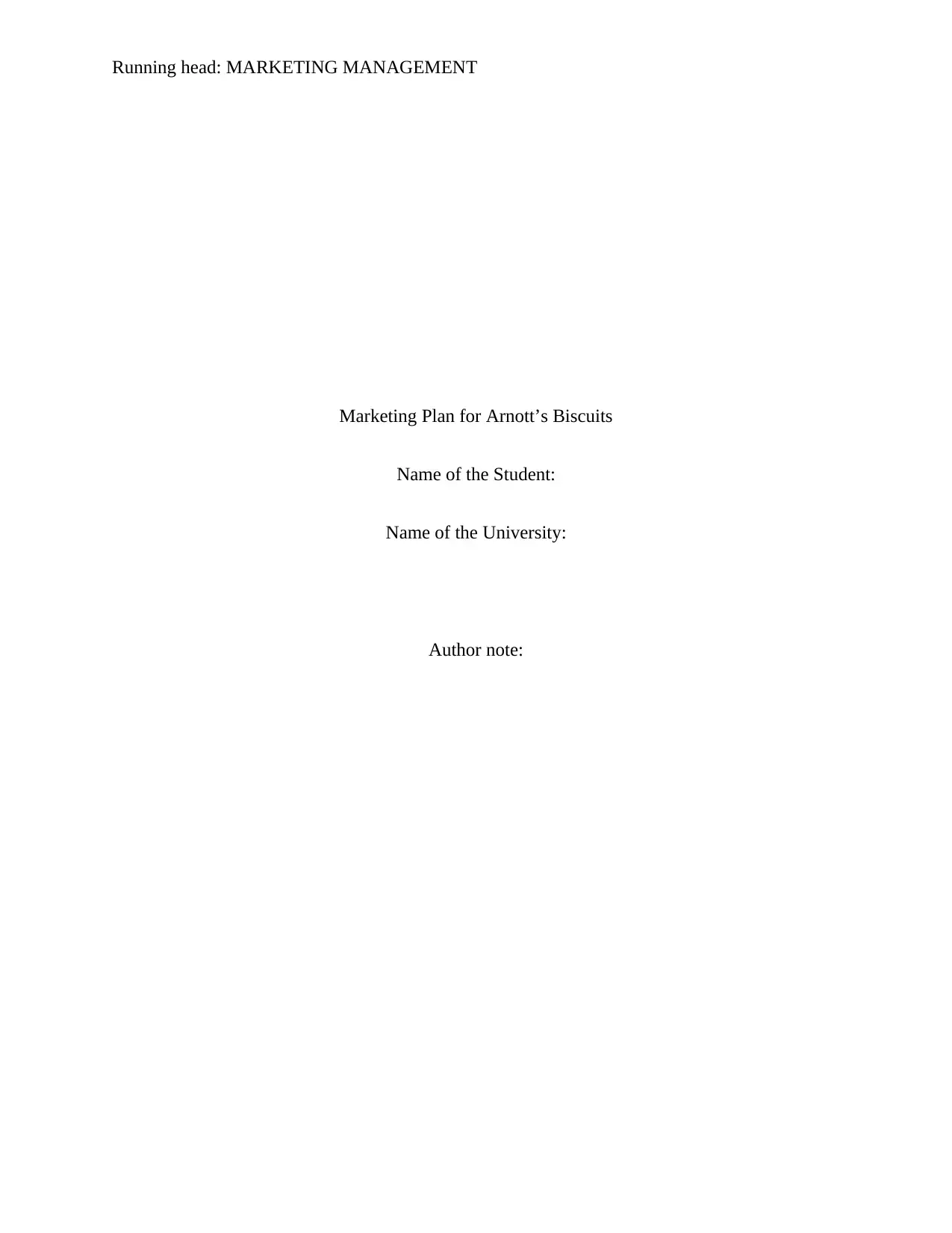
Running head: MARKETING MANAGEMENT
Marketing Plan for Arnott’s Biscuits
Name of the Student:
Name of the University:
Author note:
Marketing Plan for Arnott’s Biscuits
Name of the Student:
Name of the University:
Author note:
Paraphrase This Document
Need a fresh take? Get an instant paraphrase of this document with our AI Paraphraser

1MARKETING MANAGEMENT
Executive summary
Arnott’s Biscuits is the biggest biscuit manufacturing company in Australia and second biggest
suppliers of snacks items. Apart from the signature biscuit, the company has diversified its
business into producing many of snacks items, such as, shortbread, breads, custard creams,
desserts, crackers, syrup, coconut rings, fruit roll, tarts, and many more (Arnott's Australia,
2018). In this report, a marketing plan for the company has been presented. Through internal
analysis, it has been found that the company faces competition from many local and global
companies that offer cheaper substitute and it has a smaller share outside Australia. Hence, the
marketing strategies of the company should focus on those areas and must design and implement
appropriate promotional strategies increase its market share.
Executive summary
Arnott’s Biscuits is the biggest biscuit manufacturing company in Australia and second biggest
suppliers of snacks items. Apart from the signature biscuit, the company has diversified its
business into producing many of snacks items, such as, shortbread, breads, custard creams,
desserts, crackers, syrup, coconut rings, fruit roll, tarts, and many more (Arnott's Australia,
2018). In this report, a marketing plan for the company has been presented. Through internal
analysis, it has been found that the company faces competition from many local and global
companies that offer cheaper substitute and it has a smaller share outside Australia. Hence, the
marketing strategies of the company should focus on those areas and must design and implement
appropriate promotional strategies increase its market share.
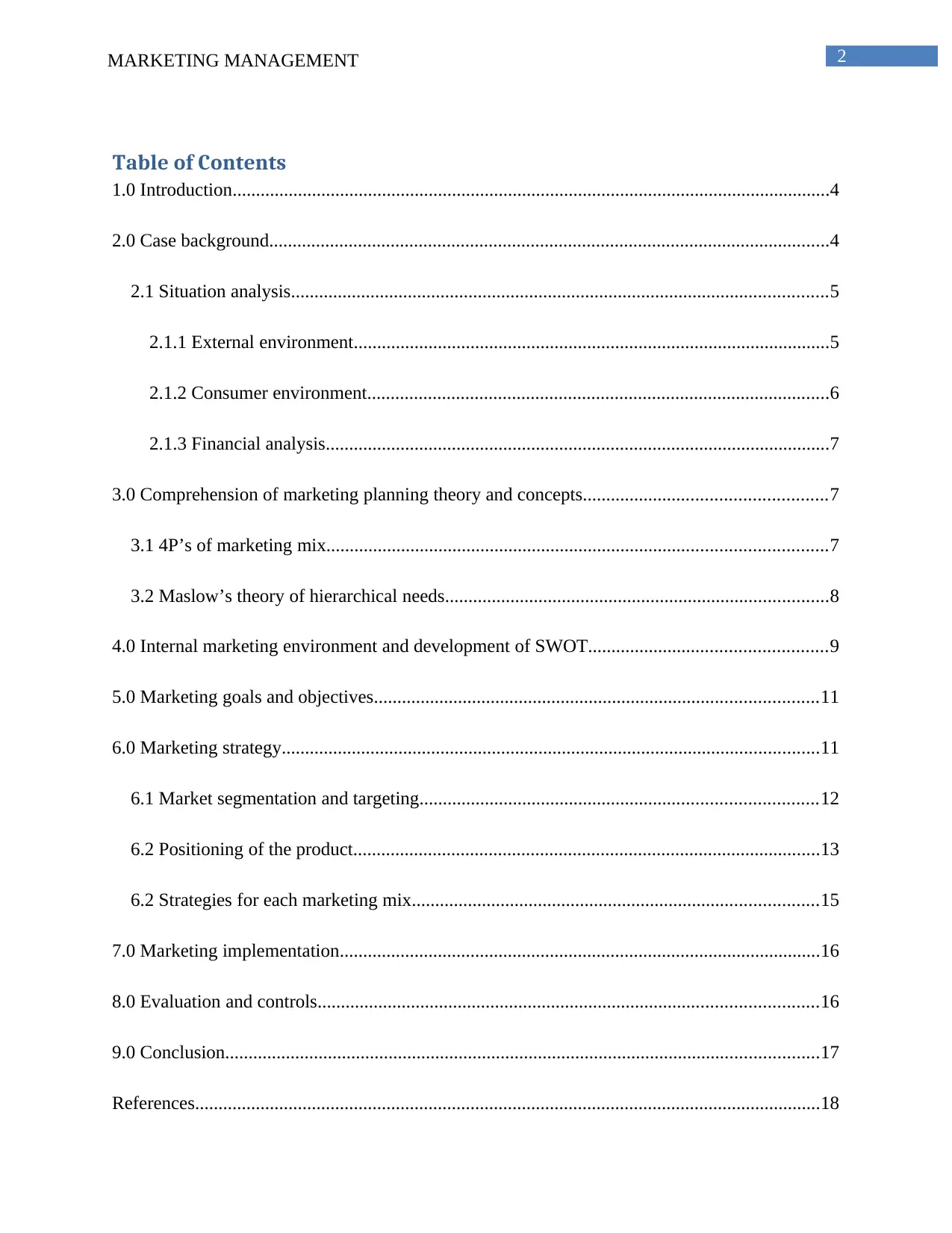
2MARKETING MANAGEMENT
Table of Contents
1.0 Introduction................................................................................................................................4
2.0 Case background........................................................................................................................4
2.1 Situation analysis...................................................................................................................5
2.1.1 External environment......................................................................................................5
2.1.2 Consumer environment...................................................................................................6
2.1.3 Financial analysis............................................................................................................7
3.0 Comprehension of marketing planning theory and concepts....................................................7
3.1 4P’s of marketing mix...........................................................................................................7
3.2 Maslow’s theory of hierarchical needs..................................................................................8
4.0 Internal marketing environment and development of SWOT...................................................9
5.0 Marketing goals and objectives...............................................................................................11
6.0 Marketing strategy...................................................................................................................11
6.1 Market segmentation and targeting.....................................................................................12
6.2 Positioning of the product....................................................................................................13
6.2 Strategies for each marketing mix.......................................................................................15
7.0 Marketing implementation.......................................................................................................16
8.0 Evaluation and controls...........................................................................................................16
9.0 Conclusion...............................................................................................................................17
References......................................................................................................................................18
Table of Contents
1.0 Introduction................................................................................................................................4
2.0 Case background........................................................................................................................4
2.1 Situation analysis...................................................................................................................5
2.1.1 External environment......................................................................................................5
2.1.2 Consumer environment...................................................................................................6
2.1.3 Financial analysis............................................................................................................7
3.0 Comprehension of marketing planning theory and concepts....................................................7
3.1 4P’s of marketing mix...........................................................................................................7
3.2 Maslow’s theory of hierarchical needs..................................................................................8
4.0 Internal marketing environment and development of SWOT...................................................9
5.0 Marketing goals and objectives...............................................................................................11
6.0 Marketing strategy...................................................................................................................11
6.1 Market segmentation and targeting.....................................................................................12
6.2 Positioning of the product....................................................................................................13
6.2 Strategies for each marketing mix.......................................................................................15
7.0 Marketing implementation.......................................................................................................16
8.0 Evaluation and controls...........................................................................................................16
9.0 Conclusion...............................................................................................................................17
References......................................................................................................................................18
⊘ This is a preview!⊘
Do you want full access?
Subscribe today to unlock all pages.

Trusted by 1+ million students worldwide

3MARKETING MANAGEMENT
Appendix........................................................................................................................................20
Appendix........................................................................................................................................20
Paraphrase This Document
Need a fresh take? Get an instant paraphrase of this document with our AI Paraphraser

4MARKETING MANAGEMENT
1.0 Introduction
Arnott’s Biscuits is the biggest biscuit manufacturing company in Australia and second
biggest suppliers of snacks items. Apart from the signature biscuit, the company has diversified
its business into producing many of snacks items, such as, shortbread, breads, custard creams,
desserts, crackers, syrup, coconut rings, fruit roll, tarts, and many more (Arnott's Australia,
2018). The company has been recently facing some threats and challenges from various factors,
such as, strong competitors in the biscuit making industry, such as, Kraft Foods Ltd, Griffins
Foods Ltd, and Goodman Fielder Ltd, entry of international biscuit companies, and competition
from the less expensive products, that have the potential to replace the more expensive products
and reduce the profitability of the company. The purpose of this report is to present a marketing
plan for Arnott’s Biscuits. With the situational analysis, internal analysis of the business, the
report will present the marketing goals and objectives, marketing strategy, implementation
strategy, monitoring and controlling strategy. This plan will highlight the limitations and scope
of the company too while implementing the plan.
2.0 Case background
Arnott's Biscuits has been ruling the biscuit and snacks market in Australia for more than
150 years. With these long years of history, the company is not only a mere food company, but it
has also become one of the national icons of Australia. The portfolio of the company includes
many household names, such as, Tiny Teddy, Iced VoVo, Tim Tam, SAO, Shapes, Vita-Weat,
and Salada. Not only in Australia, but the company is one of the biggest food companies in the
Asia Pacific region also (Bigliardi & Galati, 2013). With the support of the Campbell Soup
1.0 Introduction
Arnott’s Biscuits is the biggest biscuit manufacturing company in Australia and second
biggest suppliers of snacks items. Apart from the signature biscuit, the company has diversified
its business into producing many of snacks items, such as, shortbread, breads, custard creams,
desserts, crackers, syrup, coconut rings, fruit roll, tarts, and many more (Arnott's Australia,
2018). The company has been recently facing some threats and challenges from various factors,
such as, strong competitors in the biscuit making industry, such as, Kraft Foods Ltd, Griffins
Foods Ltd, and Goodman Fielder Ltd, entry of international biscuit companies, and competition
from the less expensive products, that have the potential to replace the more expensive products
and reduce the profitability of the company. The purpose of this report is to present a marketing
plan for Arnott’s Biscuits. With the situational analysis, internal analysis of the business, the
report will present the marketing goals and objectives, marketing strategy, implementation
strategy, monitoring and controlling strategy. This plan will highlight the limitations and scope
of the company too while implementing the plan.
2.0 Case background
Arnott's Biscuits has been ruling the biscuit and snacks market in Australia for more than
150 years. With these long years of history, the company is not only a mere food company, but it
has also become one of the national icons of Australia. The portfolio of the company includes
many household names, such as, Tiny Teddy, Iced VoVo, Tim Tam, SAO, Shapes, Vita-Weat,
and Salada. Not only in Australia, but the company is one of the biggest food companies in the
Asia Pacific region also (Bigliardi & Galati, 2013). With the support of the Campbell Soup
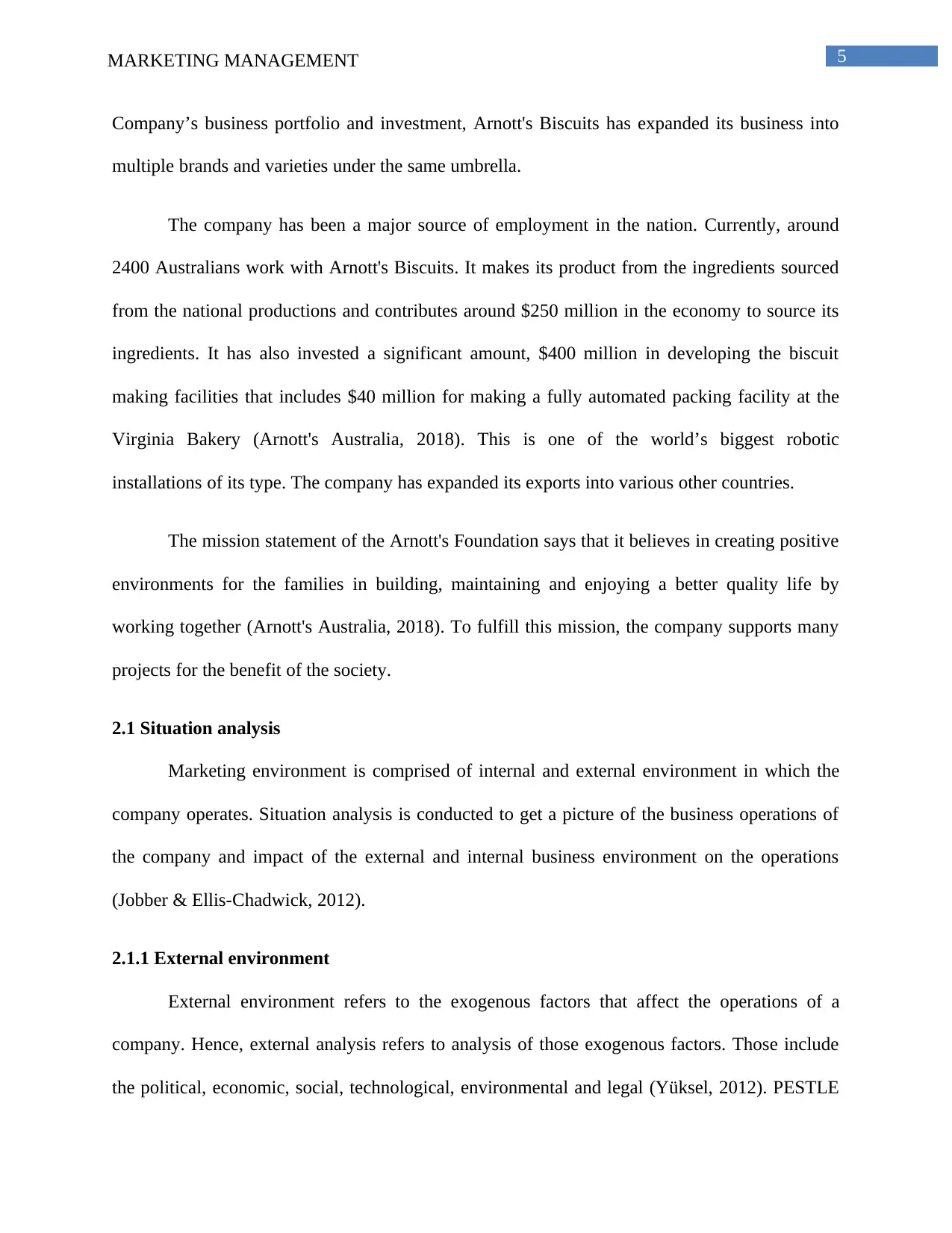
5MARKETING MANAGEMENT
Company’s business portfolio and investment, Arnott's Biscuits has expanded its business into
multiple brands and varieties under the same umbrella.
The company has been a major source of employment in the nation. Currently, around
2400 Australians work with Arnott's Biscuits. It makes its product from the ingredients sourced
from the national productions and contributes around $250 million in the economy to source its
ingredients. It has also invested a significant amount, $400 million in developing the biscuit
making facilities that includes $40 million for making a fully automated packing facility at the
Virginia Bakery (Arnott's Australia, 2018). This is one of the world’s biggest robotic
installations of its type. The company has expanded its exports into various other countries.
The mission statement of the Arnott's Foundation says that it believes in creating positive
environments for the families in building, maintaining and enjoying a better quality life by
working together (Arnott's Australia, 2018). To fulfill this mission, the company supports many
projects for the benefit of the society.
2.1 Situation analysis
Marketing environment is comprised of internal and external environment in which the
company operates. Situation analysis is conducted to get a picture of the business operations of
the company and impact of the external and internal business environment on the operations
(Jobber & Ellis-Chadwick, 2012).
2.1.1 External environment
External environment refers to the exogenous factors that affect the operations of a
company. Hence, external analysis refers to analysis of those exogenous factors. Those include
the political, economic, social, technological, environmental and legal (Yüksel, 2012). PESTLE
Company’s business portfolio and investment, Arnott's Biscuits has expanded its business into
multiple brands and varieties under the same umbrella.
The company has been a major source of employment in the nation. Currently, around
2400 Australians work with Arnott's Biscuits. It makes its product from the ingredients sourced
from the national productions and contributes around $250 million in the economy to source its
ingredients. It has also invested a significant amount, $400 million in developing the biscuit
making facilities that includes $40 million for making a fully automated packing facility at the
Virginia Bakery (Arnott's Australia, 2018). This is one of the world’s biggest robotic
installations of its type. The company has expanded its exports into various other countries.
The mission statement of the Arnott's Foundation says that it believes in creating positive
environments for the families in building, maintaining and enjoying a better quality life by
working together (Arnott's Australia, 2018). To fulfill this mission, the company supports many
projects for the benefit of the society.
2.1 Situation analysis
Marketing environment is comprised of internal and external environment in which the
company operates. Situation analysis is conducted to get a picture of the business operations of
the company and impact of the external and internal business environment on the operations
(Jobber & Ellis-Chadwick, 2012).
2.1.1 External environment
External environment refers to the exogenous factors that affect the operations of a
company. Hence, external analysis refers to analysis of those exogenous factors. Those include
the political, economic, social, technological, environmental and legal (Yüksel, 2012). PESTLE
⊘ This is a preview!⊘
Do you want full access?
Subscribe today to unlock all pages.

Trusted by 1+ million students worldwide

6MARKETING MANAGEMENT
analysis tool is the most appropriate tools for this analysis. As discussed in the previous
assignment on external environmental analysis, it is found that, there is no major political
obstacle in the country; rather it provides encouragement for business growth. There is also no
economic obstacle and the country has been experiencing longest running economic growth,
which is beneficial for any business. On the social front, there is adequate supply of labor.
However, the changing dynamics of the consumer preferences is a challenging factor Arnott's
Biscuits. On the technological front, the company has been investing huge amount of capital in
developing and installing the latest technologies for business, which increases productivity and
performance of the company. There is no environmental threat to Arnott's Biscuits and it is also
trying to reduce its environmental footprint by implementing various effective technologies and
investing in CSR. Lastly, the company is free from any legal obligations, helping in the
expanding the business. Thus, it can be said that the company has favorable external market
environment, which promotes business growth.
The opportunities and threats have also been identified in the previous assignment. It says
that the company has the opportunity of expanding in the breakfast and beverage section, in the
international market, and for using more advanced technologies for compensating the labor
deficit. On the other hand, it faces strong competitions from less costly products, and renowned
competitors as well as from international competitors.
2.1.2 Consumer environment
This environment refers to the target market and factors affecting the purchasing behavior
of the consumers. Arnott's Biscuits has targeted people of all ages, from 4 years and above and
all types of tastes. Hence, over time, they have introduced numerous different types of biscuits in
analysis tool is the most appropriate tools for this analysis. As discussed in the previous
assignment on external environmental analysis, it is found that, there is no major political
obstacle in the country; rather it provides encouragement for business growth. There is also no
economic obstacle and the country has been experiencing longest running economic growth,
which is beneficial for any business. On the social front, there is adequate supply of labor.
However, the changing dynamics of the consumer preferences is a challenging factor Arnott's
Biscuits. On the technological front, the company has been investing huge amount of capital in
developing and installing the latest technologies for business, which increases productivity and
performance of the company. There is no environmental threat to Arnott's Biscuits and it is also
trying to reduce its environmental footprint by implementing various effective technologies and
investing in CSR. Lastly, the company is free from any legal obligations, helping in the
expanding the business. Thus, it can be said that the company has favorable external market
environment, which promotes business growth.
The opportunities and threats have also been identified in the previous assignment. It says
that the company has the opportunity of expanding in the breakfast and beverage section, in the
international market, and for using more advanced technologies for compensating the labor
deficit. On the other hand, it faces strong competitions from less costly products, and renowned
competitors as well as from international competitors.
2.1.2 Consumer environment
This environment refers to the target market and factors affecting the purchasing behavior
of the consumers. Arnott's Biscuits has targeted people of all ages, from 4 years and above and
all types of tastes. Hence, over time, they have introduced numerous different types of biscuits in
Paraphrase This Document
Need a fresh take? Get an instant paraphrase of this document with our AI Paraphraser

7MARKETING MANAGEMENT
the market. They have been also producing various different snacks item, which would capture
the attention of the target market. The prices of the products are reasonable and affordable for all.
2.1.3 Financial analysis
According to the annual report of 2017 of Arnott's Biscuits, it is seen that the net sales
was $7,890 and gross profit was $3,059 in 2017. The net earnings in 2017 were $887 million
(Arnott’s Australia, 2018). Apart from production, it spends $250 million to procure the raw
materials and agricultural supplies for production every year, which amounts to $3 billion in the
past decade. It invests in technology development. The data from the annual report is attached in
the appendix.
3.0 Comprehension of marketing planning theory and concepts
3.1 4P’s of marketing mix
Marketing theories and concepts describe the factors and conditions that are applied in
the marketing planning and strategies. The marketing mix is one of the most commonly used
theories in making marketing strategies. It helps to understand what a product or service can
offer and how to plan for that. 4Ps of marketing mix is a tool that represents product, place, price
and promotional strategies for a product or service (Baker, 2014).
the market. They have been also producing various different snacks item, which would capture
the attention of the target market. The prices of the products are reasonable and affordable for all.
2.1.3 Financial analysis
According to the annual report of 2017 of Arnott's Biscuits, it is seen that the net sales
was $7,890 and gross profit was $3,059 in 2017. The net earnings in 2017 were $887 million
(Arnott’s Australia, 2018). Apart from production, it spends $250 million to procure the raw
materials and agricultural supplies for production every year, which amounts to $3 billion in the
past decade. It invests in technology development. The data from the annual report is attached in
the appendix.
3.0 Comprehension of marketing planning theory and concepts
3.1 4P’s of marketing mix
Marketing theories and concepts describe the factors and conditions that are applied in
the marketing planning and strategies. The marketing mix is one of the most commonly used
theories in making marketing strategies. It helps to understand what a product or service can
offer and how to plan for that. 4Ps of marketing mix is a tool that represents product, place, price
and promotional strategies for a product or service (Baker, 2014).
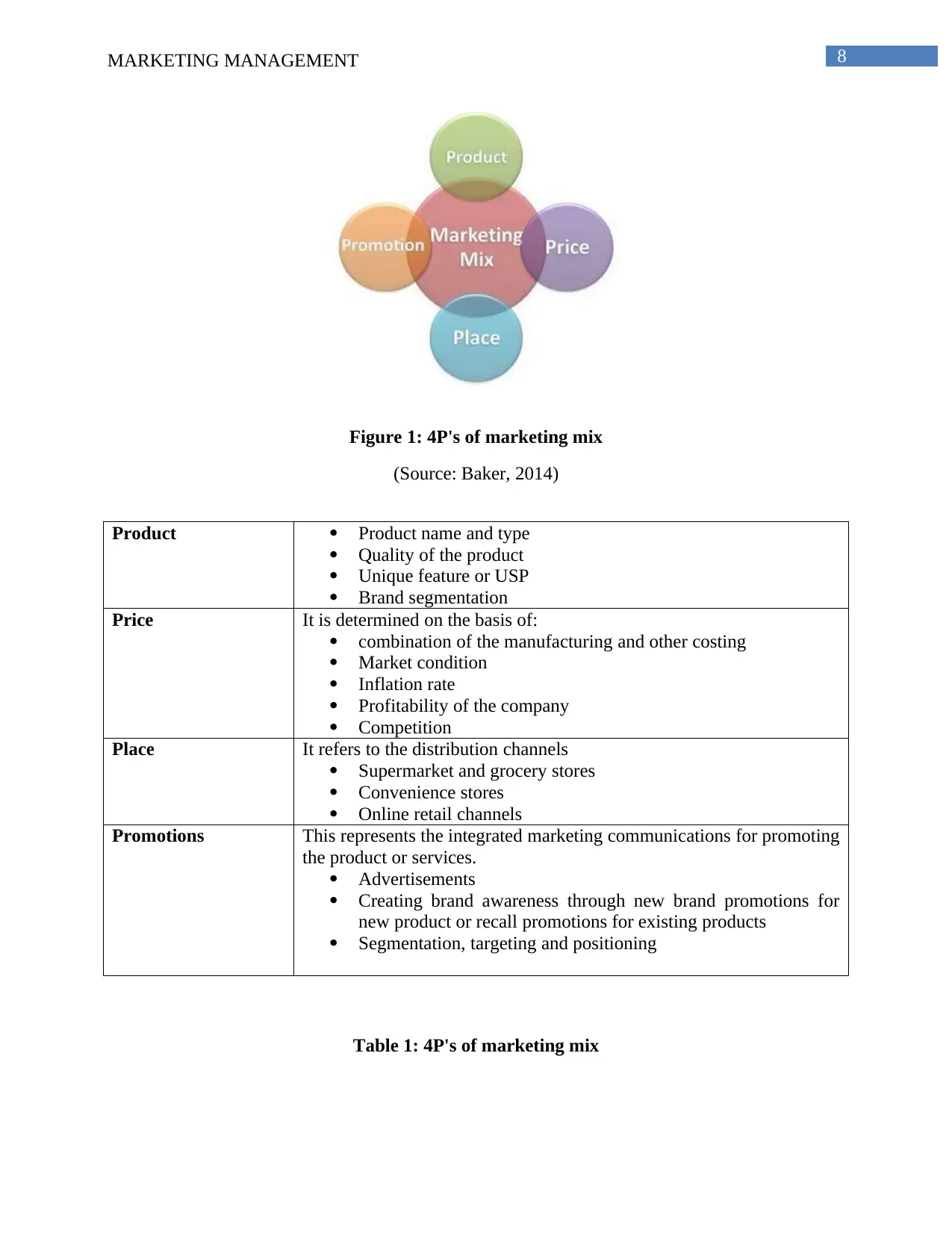
8MARKETING MANAGEMENT
Figure 1: 4P's of marketing mix
(Source: Baker, 2014)
Product Product name and type
Quality of the product
Unique feature or USP
Brand segmentation
Price It is determined on the basis of:
combination of the manufacturing and other costing
Market condition
Inflation rate
Profitability of the company
Competition
Place It refers to the distribution channels
Supermarket and grocery stores
Convenience stores
Online retail channels
Promotions This represents the integrated marketing communications for promoting
the product or services.
Advertisements
Creating brand awareness through new brand promotions for
new product or recall promotions for existing products
Segmentation, targeting and positioning
Table 1: 4P's of marketing mix
Figure 1: 4P's of marketing mix
(Source: Baker, 2014)
Product Product name and type
Quality of the product
Unique feature or USP
Brand segmentation
Price It is determined on the basis of:
combination of the manufacturing and other costing
Market condition
Inflation rate
Profitability of the company
Competition
Place It refers to the distribution channels
Supermarket and grocery stores
Convenience stores
Online retail channels
Promotions This represents the integrated marketing communications for promoting
the product or services.
Advertisements
Creating brand awareness through new brand promotions for
new product or recall promotions for existing products
Segmentation, targeting and positioning
Table 1: 4P's of marketing mix
⊘ This is a preview!⊘
Do you want full access?
Subscribe today to unlock all pages.

Trusted by 1+ million students worldwide
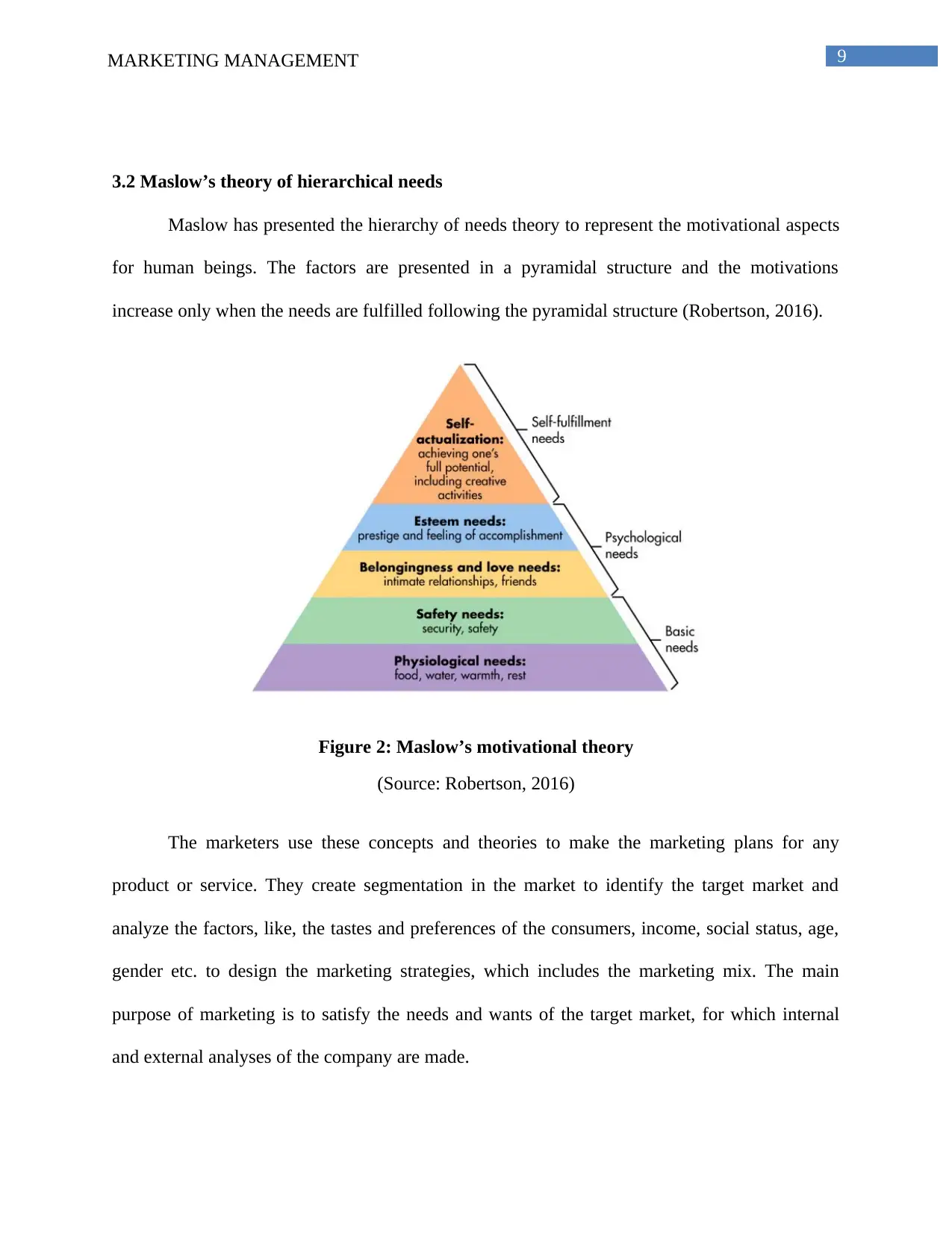
9MARKETING MANAGEMENT
3.2 Maslow’s theory of hierarchical needs
Maslow has presented the hierarchy of needs theory to represent the motivational aspects
for human beings. The factors are presented in a pyramidal structure and the motivations
increase only when the needs are fulfilled following the pyramidal structure (Robertson, 2016).
Figure 2: Maslow’s motivational theory
(Source: Robertson, 2016)
The marketers use these concepts and theories to make the marketing plans for any
product or service. They create segmentation in the market to identify the target market and
analyze the factors, like, the tastes and preferences of the consumers, income, social status, age,
gender etc. to design the marketing strategies, which includes the marketing mix. The main
purpose of marketing is to satisfy the needs and wants of the target market, for which internal
and external analyses of the company are made.
3.2 Maslow’s theory of hierarchical needs
Maslow has presented the hierarchy of needs theory to represent the motivational aspects
for human beings. The factors are presented in a pyramidal structure and the motivations
increase only when the needs are fulfilled following the pyramidal structure (Robertson, 2016).
Figure 2: Maslow’s motivational theory
(Source: Robertson, 2016)
The marketers use these concepts and theories to make the marketing plans for any
product or service. They create segmentation in the market to identify the target market and
analyze the factors, like, the tastes and preferences of the consumers, income, social status, age,
gender etc. to design the marketing strategies, which includes the marketing mix. The main
purpose of marketing is to satisfy the needs and wants of the target market, for which internal
and external analyses of the company are made.
Paraphrase This Document
Need a fresh take? Get an instant paraphrase of this document with our AI Paraphraser

10MARKETING MANAGEMENT
4.0 Internal marketing environment and development of SWOT
Internal environment of a company refers to the internal factors that affect the business
operations. Internal factors refer to the organizational elements, such as, employees,
management, culture, budget, events, and business conditions that influence the activities and
performance of a business (Armstrong et al., 2015). The best tool to analyze the internal
environment is the SWOT analysis. SWOT stands for Strengths, Weaknesses, Opportunities and
Threats.
A SWOT analysis will be performed for identifying the strengths and weakness of the
Arnott's Biscuits Company to develop a relevant marketing plan.
Strengths More than a century of experience in the biscuit industry
Hugely diversified products
One of the largest biscuit and snacks manufacturers in Australia and
Asia Pacific region
Exports to more than 40 countries in the world and hence, a strong
foothold in the international market
Weaknesses Use of only locally purchased and locally grown products
Small market share outside Australia
Some of the products are expensive
Opportunities Expansion in the international market
Increase fortified food products
Expansion in breakfast cereal, cookies and beverage segment
Threats Strong competition from various local and international competitors,
like, Kraft Foods Ltd, Griffins Food Ltd, and Goodman Fielder Ltd
Less expensive substitute products in the market
Table 2: SWOT analysis for Arnott's Biscuits
4.0 Internal marketing environment and development of SWOT
Internal environment of a company refers to the internal factors that affect the business
operations. Internal factors refer to the organizational elements, such as, employees,
management, culture, budget, events, and business conditions that influence the activities and
performance of a business (Armstrong et al., 2015). The best tool to analyze the internal
environment is the SWOT analysis. SWOT stands for Strengths, Weaknesses, Opportunities and
Threats.
A SWOT analysis will be performed for identifying the strengths and weakness of the
Arnott's Biscuits Company to develop a relevant marketing plan.
Strengths More than a century of experience in the biscuit industry
Hugely diversified products
One of the largest biscuit and snacks manufacturers in Australia and
Asia Pacific region
Exports to more than 40 countries in the world and hence, a strong
foothold in the international market
Weaknesses Use of only locally purchased and locally grown products
Small market share outside Australia
Some of the products are expensive
Opportunities Expansion in the international market
Increase fortified food products
Expansion in breakfast cereal, cookies and beverage segment
Threats Strong competition from various local and international competitors,
like, Kraft Foods Ltd, Griffins Food Ltd, and Goodman Fielder Ltd
Less expensive substitute products in the market
Table 2: SWOT analysis for Arnott's Biscuits
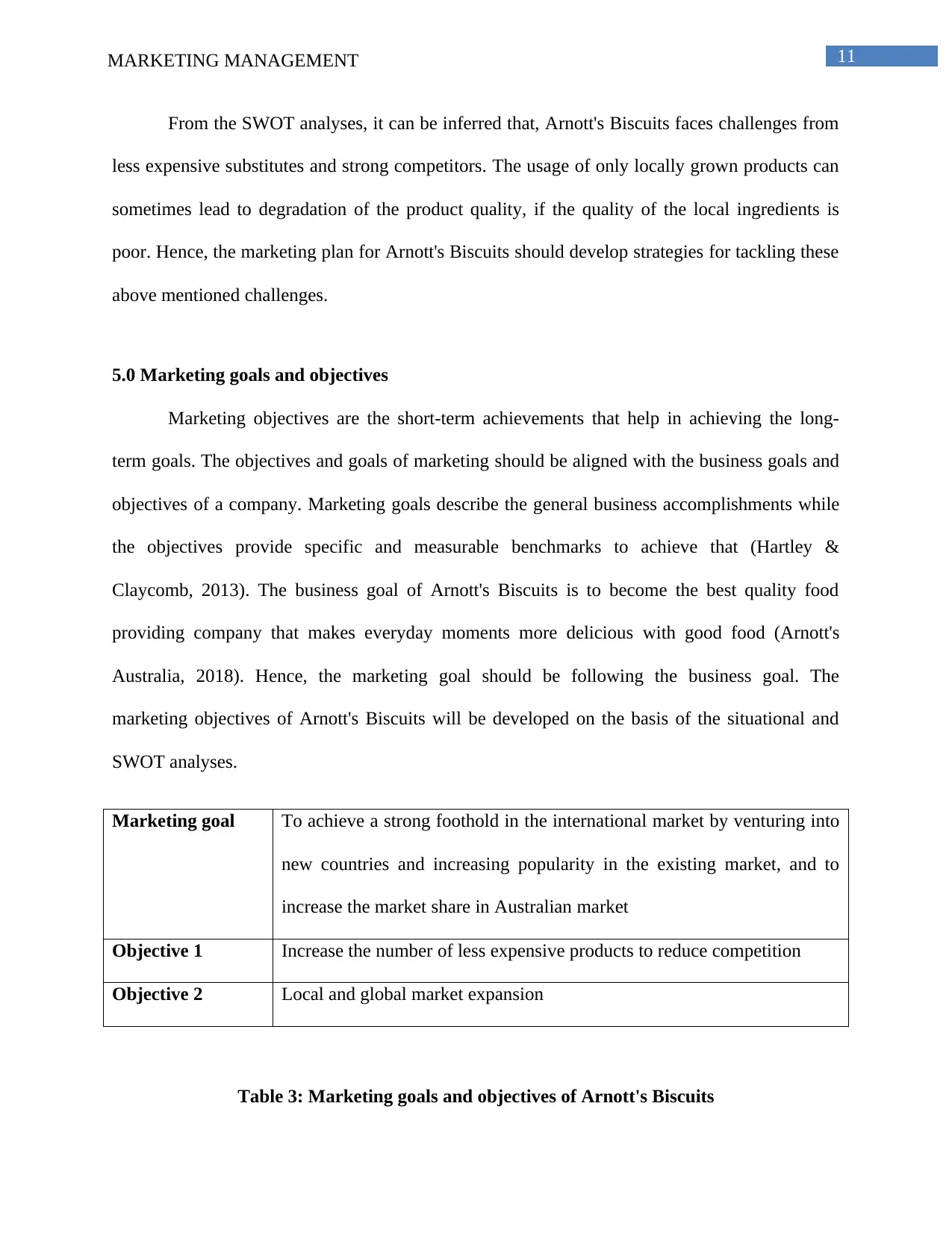
11MARKETING MANAGEMENT
From the SWOT analyses, it can be inferred that, Arnott's Biscuits faces challenges from
less expensive substitutes and strong competitors. The usage of only locally grown products can
sometimes lead to degradation of the product quality, if the quality of the local ingredients is
poor. Hence, the marketing plan for Arnott's Biscuits should develop strategies for tackling these
above mentioned challenges.
5.0 Marketing goals and objectives
Marketing objectives are the short-term achievements that help in achieving the long-
term goals. The objectives and goals of marketing should be aligned with the business goals and
objectives of a company. Marketing goals describe the general business accomplishments while
the objectives provide specific and measurable benchmarks to achieve that (Hartley &
Claycomb, 2013). The business goal of Arnott's Biscuits is to become the best quality food
providing company that makes everyday moments more delicious with good food (Arnott's
Australia, 2018). Hence, the marketing goal should be following the business goal. The
marketing objectives of Arnott's Biscuits will be developed on the basis of the situational and
SWOT analyses.
Marketing goal To achieve a strong foothold in the international market by venturing into
new countries and increasing popularity in the existing market, and to
increase the market share in Australian market
Objective 1 Increase the number of less expensive products to reduce competition
Objective 2 Local and global market expansion
Table 3: Marketing goals and objectives of Arnott's Biscuits
From the SWOT analyses, it can be inferred that, Arnott's Biscuits faces challenges from
less expensive substitutes and strong competitors. The usage of only locally grown products can
sometimes lead to degradation of the product quality, if the quality of the local ingredients is
poor. Hence, the marketing plan for Arnott's Biscuits should develop strategies for tackling these
above mentioned challenges.
5.0 Marketing goals and objectives
Marketing objectives are the short-term achievements that help in achieving the long-
term goals. The objectives and goals of marketing should be aligned with the business goals and
objectives of a company. Marketing goals describe the general business accomplishments while
the objectives provide specific and measurable benchmarks to achieve that (Hartley &
Claycomb, 2013). The business goal of Arnott's Biscuits is to become the best quality food
providing company that makes everyday moments more delicious with good food (Arnott's
Australia, 2018). Hence, the marketing goal should be following the business goal. The
marketing objectives of Arnott's Biscuits will be developed on the basis of the situational and
SWOT analyses.
Marketing goal To achieve a strong foothold in the international market by venturing into
new countries and increasing popularity in the existing market, and to
increase the market share in Australian market
Objective 1 Increase the number of less expensive products to reduce competition
Objective 2 Local and global market expansion
Table 3: Marketing goals and objectives of Arnott's Biscuits
⊘ This is a preview!⊘
Do you want full access?
Subscribe today to unlock all pages.

Trusted by 1+ million students worldwide
1 out of 21
Your All-in-One AI-Powered Toolkit for Academic Success.
+13062052269
info@desklib.com
Available 24*7 on WhatsApp / Email
![[object Object]](/_next/static/media/star-bottom.7253800d.svg)
Unlock your academic potential
Copyright © 2020–2025 A2Z Services. All Rights Reserved. Developed and managed by ZUCOL.


